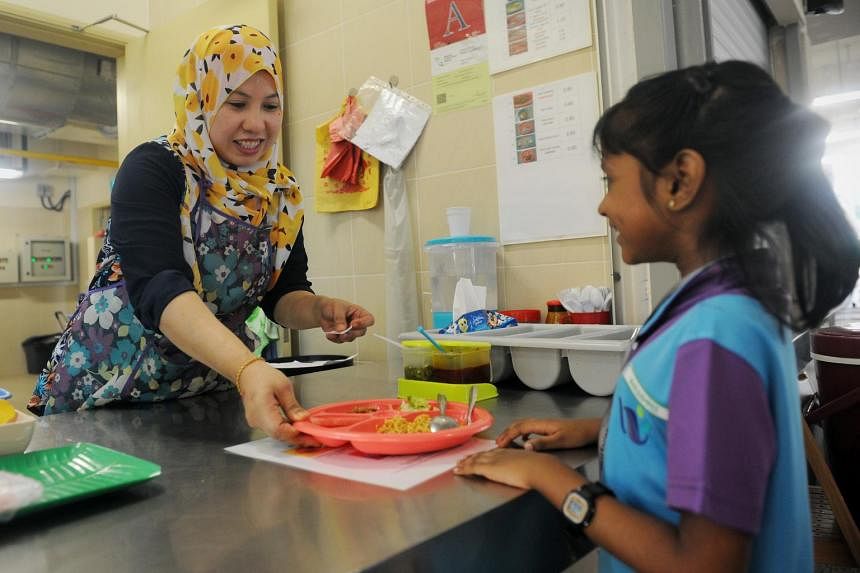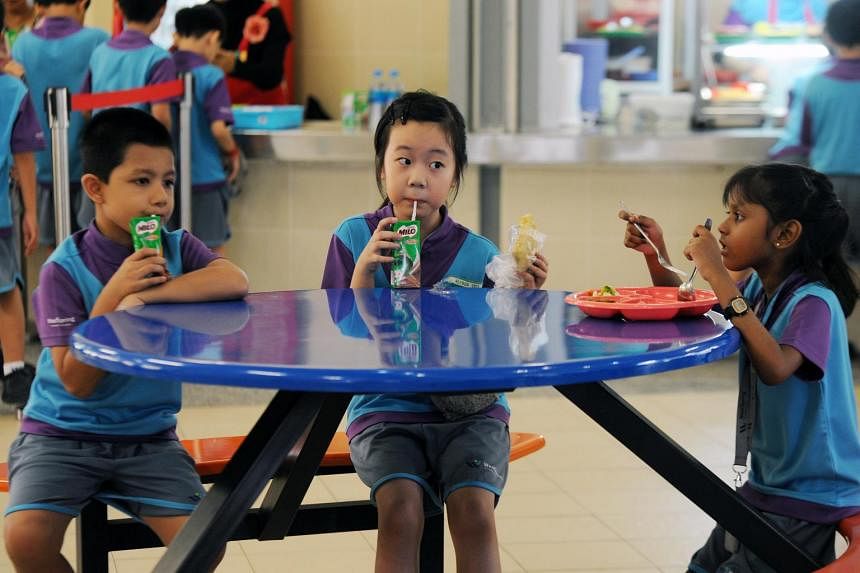At West Spring Primary School, some parents can be assured that their children are having healthy meals.
They have pre-ordered the meals through Whizmeal, an online ordering platform and healthy-eating programme designed by a local start-up of the same name.
In January, the system went live at the relatively new school, which currently has only Primary 1 and 2 pupils. Almost 70 out of the 480 pupils, including those on the financial assistance scheme, are using the system, said Madam Tan Soon Mei, who founded Whizmeal when she found herself worrying about what her two daughters - aged three and four - would eat when they go to primary school.
She is in the process of getting Whizmeal up and running at another primary school - an established one - in July. There, the principal has decided to offer it first to about 200 kids with weight issues.
The parents using the system at West Spring Primary can choose from main meals, such as nasi lemak, malay rice and pasta - all of which come with a portion of fruit and vegetables. Drinks and snacks, such as pau, are also on offer.
There is no deep-fried food and few processed items are used.
"Kids being kids, they might over-order or they might buy only snacks. With the online system, the parents can limit the calories which their child will consume and make sure he is eating properly," said the principal of West Spring Primary, Mrs Jacinta Lim.
HOW THE PROGRAMME WORKS
Before launching the programme, Whizmeal worked with the four stallholders at West Spring Primary to craft healthier meals it could offer online.
The stallholders were educated on the Health Promotion Board's (HPB) healthy-eating guidelines. They were also advised on menu-planning and cost considerations, said Madam Tan, who was a canteen stall operator for eight years - first at a private school and then at a primary school.
Stallholders are sold on the new concept, mainly due to income predictability, she said.
They do not pay a cent and get advance orders, which helps them with their shopping and budgeting. They are also paid a month in advance.
Parents pay $15 for a yearly subscription. They then order and pay for the food online a month ahead.
They print and cut out the meal coupons for their children to collect the food at the stalls.
Parents have a choice of non-halal, halal and vegetarian meals. The nutritional content of the dishes is provided, except for food that is not prepared by the stallholders, which includes snacks.
-
Local fare filled with goodness
-
A local start-up, Whizmeal, has started offering healthier meals at West Spring Primary School, with plans to roll out its programme to more schools.
The agency works with stallholders to put together balanced meals on their menu.
The key is to serve the main meals with a portion of fruit and vegetables and use fewer processed items, said Madam Tan Soon Mei, who founded the programme.
"We advised them on replacing fried food and processed food with healthier ingredients," she said, adding that this is done with the vendors' budgets in mind.
Here is a look at three dishes on the menu.
NASI LEMAK
The original: The star of this classic Malay dish is its fragrant rice. It is cooked in coconut milk, which is high in saturated fat and calories.
The rice is often accompanied by various side dishes, such as deep-fried ikan bilis, peanuts, fried fish, chicken wings, fried egg, omelette and cucumber slices.
The healthier version: The rice is cooked with an equal mix of coconut milk and low-fat evaporated milk.
The deep-fried items have been done away with, and the dish is accompanied by a piece of fried omelette, a portion of stir-fried green vegetables and a portion of fruit.
HAINANESE CHICKEN RICE
The original: This popular local dish is high in fat. Chicken fat is used in the cooking of the rice and the chicken is served with its skin intact.
The healthier version: The dish is served with skinless and boneless chicken. The stock left over from boiling the chicken is used to cook the rice, of which 20 per cent is brown rice.
LAKSA
The original: This is another popular local dish, consisting of thick rice noodles in a rich coconut-milk gravy.
The healthier version: Half of the coconut milk used in the gravy is replaced with low-fat evaporated milk. More bean sprouts and a portion of fruit are added to the dish.
Pupils who are not on the programme buy food from the stallholders directly. They have a choice of typical canteen dishes, such as pasta and mee soto, but these may not be balanced meals. Snacks, such as corn chips, are available as well.
The school's canteen does not sell soft drinks, said Mrs Lim. Once a week, pupils eat a different fruit in class with the teacher, with the aim of exposing them to a variety of fruits.
Still, medical technologist Adriana Ismail was worried that her son, Muhammad Ariq Anaqi Mohdhar Bashadi, seven, may eat only snacks when left to his own devices at recess time.
She did not hesitate to sign up for the Whizmeal programme. "We engage him when we choose the food. We educate him and tell him why we chose those dishes. It's also a bonding session."
Graphic designer Wendy Leo said it was her daughter, Alyssa, eight, who told her about "the special queue that is faster".
She joined the programme for the convenience - it is faster as stallholders can plate the dishes in advance - but realised the food is "pretty healthy".
"I will go through the menu with my daughter so I know what she is eating in school," she said. "I am not
health conscious. We eat junk food at home sometimes, so it's good that she eats fairly healthily during recess."
Mrs Lim noted that the process also helps parents to be more aware of their own dietary needs.
"If we don't offer this opportunity, some parents may not learn about calorie intake and the importance of reading food labels."
GROWING AWARENESS OF NUTRITION
West Spring Primary joins a growing pool of schools in Singapore which are making an effort to improve their pupils' nutrition.
The HPB's Healthy Meals In Schools Programme has guidelines for childcare centres and schools to cut down on saturated fat, sugar and salt. They are also urged to serve whole grains, fruit and vegetables in meals.
About 213,000 children from more than 480 childcare centres and 130 schools have benefited from it.
This is up from the 200 childcare centres and 83 schools reported last October.
Under the initiative, a team of nutritionists and chefs conducts nutrition education and imparts culinary skills to cooks and canteen vendors, said its spokesman.
HPB will work with even more childcare centres and schools over the next few years, he added.
While healthy eating in schools is desirable, it is not easy for Whizmeal to get schools to buy into the concept.
For one thing, school meals may not be a top priority for some institutions, as academic performance and co-curricular activities take precedence, said Madam Tan.
This observation was gleaned after speaking to a few other primary schools here, as well as schools in Malaysia, Brunei and Indonesia.
Implementation of a healthy-eating programme also takes time, she said.
"Many stakeholders need to be aligned: principals, stallholders, school administrators, teachers, parents and students."
Managing stallholders and parents' expectations of what is healthy can be challenging.
For instance, stallholders may want to sell only what they know and not do any extra work, she said.
"The Health Promotion Board has guidelines on healthy eating in schools, but the problem is in making sure the stallholders continue to follow the guidelines," said Madam Tan.
For instance, some may not know how to incorporate brown rice - which tends to be more expensive - and still keep their food costs low.
Said the HPB spokesman: "Inculcating healthy eating habits in children and young people takes time as they will need to adapt to incorporating healthy food in their diet. "Having the support from schools and teachers as role models are important to help children adapt to healthier food."
CHANGE OF MINDSET NEEDED
To see healthier food in Singapore schools, institutions will first require a mindset change, argues celebrity chef Emmanuel Stroobant, who heads the canteen at Stamford American International School here.
"I think the first thing that should happen is to remove soft drinks from school canteens," says Mr Stroobant, who owns fine-dining establishment Saint Pierre and other restaurants.
"I would go even further and remove non-carbonated drinks, such as Milo and green tea, as the sugar levels in these beverages are extremely high. There is nothing as good or as pure as water."
When it comes to the food, caterers and stallholders have to know what healthy eating means, he said.
"If the people who prepare the food do not understand what is healthy versus non-healthy, I think it will be difficult to have them prepare and serve healthier meals."
For instance, to keep costs low, many stallholders may simply look for the cheapest way of feeding the children as they do not know what is healthy food, added Ms Edina Hong, marketing director of the Emmanuel Stroobant group of restaurants.
Indeed, many canteen vendors do not have a good understanding of healthy eating.
"Canteen vendors and cooks may not have experience or sufficient knowledge in preparing meals which incorporate healthier ingredients," said the HPB spokesman.
That is why HPB's programme includes culinary training, which provides them with tips on preparing those ingredients.
Schools also need to believe in healthy eating and parents need to support what the school is trying to achieve, Mr Stroobant said.
To some extent, such an initiative may need to be subsidised, as fresh ingredients tend to cost more, he said.
At Stamford American, a three-course meal with lasagne or a burger costs as much as $9, compared with less than $2 for a plate of chicken rice in a primary school.
"The difference from what is often offered in eateries is in the preparation method. While we have burgers, we do not buy premade meat patties.
"We buy the beef, mince them and incorporate chopped vegetables into the meat so that the children will get their much-needed fibre."
Gourmet caterer Preparazzi, which provides meals for a childcare centre in a prime residential district, also uses fresh ingredients. It does not use MSG, additives or palm oil, said its chef-owner Jeremy Nguee.
He charges above market rates, but said cost may not be as big as a barrier as some perceive it to be.
"As young children do not eat much, an increase of less than $1 in the daily budget means chicken breast instead of sausages, prawns instead of crab sticks and brown rice and fresh vegetables."
Many parents would pay that extra $30 a month for better food at childcare centres. However, they are not given that opportunity, he said.
"If it were up to me, I'd place school fees separately from the daily meal provision budget - parents will see how much is set aside for their children's meals.
I think the amount that is set aside for food, out of the total school fees, will be shocking for many of them."
Of course, the other barrier is the adults' mindset, said Mr Nguee.
"I think we severely underestimate children. We pigeonhole them as narrow-minded people who like only certain foods," he said.
There are food outlets which sell children's meals that consist of only deep-fried chicken nuggets and a packet of Ribena, he pointed out.
"It seems to me that it's not the children who need help, but the adults who need to be more educated about nutrition and to be armed with more ideas on how to cook healthier dishes for children."






